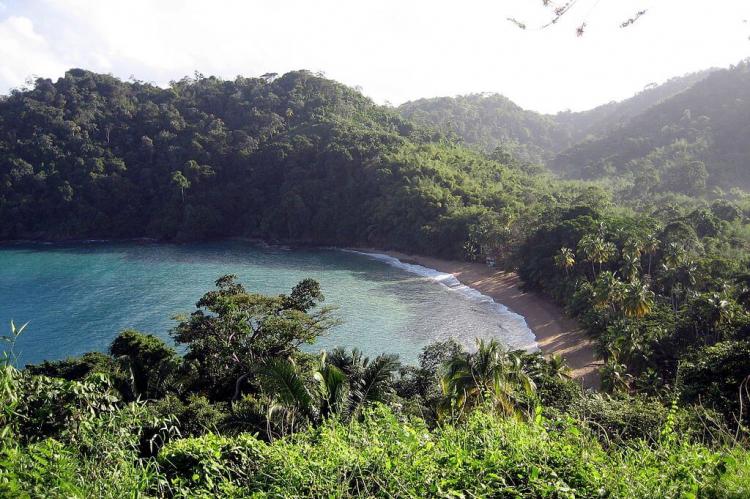From Ridge to Reef: Exploring the North-East Tobago Biosphere Reserve
The North-East Tobago Biosphere Reserve is a remarkable ecological treasure in the southeast Caribbean Sea within Trinidad and Tobago. This reserve, located in the northeast region of Tobago, spans marine and terrestrial areas and offers a unique ridge-to-ocean ecosystem.
North-East Tobago Biosphere Reserve: A Caribbean Jewel of Biodiversity and Culture
The North-East Tobago Biosphere Reserve is a remarkable ecological treasure in the southeast Caribbean Sea within Trinidad and Tobago. This reserve, located in the northeast region of Tobago, spans marine and terrestrial areas, offering a unique ridge-to-ocean ecosystem. It includes the world's oldest tropical rainforest reserve, the Tobago Main Ridge Forest Reserve, established in 1776, and hosts numerous coral reefs, bays, and offshore islands. Recognized as a significant site under the UNESCO Man and the Biosphere (MAB) Program, it stands out as a beacon of biodiversity and cultural heritage in the English-speaking Caribbean.
Geographical and Ecological Setting
Location and Zones
The North-East Tobago Biosphere Reserve covers a total area of 83,488 hectares (206,303 acres), with 15,104 hectares (37,323 acres) of terrestrial land and 68,384 hectares (168,980 acres) of marine areas. The reserve is divided into three zones:
- Core Area(s): 3,938 hectares (9,731 acres)
- Buffer Zone(s): 73,000 hectares (180,387 acres)
- Transition Zone(s): 6,550 hectares (16,185 acres)
Key Features
The reserve's marine protected area encompasses several large coral reef formations, including the renowned Man-o-War Bay and Speyside. It also includes Little Tobago Island, Goat Island, St. Giles Islands, and numerous rock formations such as the Sisters and Brothers Rocks. Bays within the reserve, such as King's Bay, Tyrrell's Bay, and Bloody Bay, contribute to its diverse marine and coastal ecosystems.
Biodiversity
Flora and Fauna
The North-East Tobago Biosphere Reserve is home to a rich diversity of species across 19 distinct habitat types, with 1,774 recorded, including 83 species listed on the International Union for Conservation of Nature (IUCN) Red List and 41 endemic species. The coral systems in the marine area host globally threatened species like Staghorn Coral (Acropora cervicornis), Elkhorn Coral (Acropora palmata), and Hawksbill Turtles (Eretmochelys imbricata).
Birdlife
The birdlife in the reserve is particularly notable, with two endemic species: the Trinidad Motmot (Momotus bahamensis) and the Tobago Greenlet (Hylophilus insularis). The offshore islands serve as crucial breeding habitats for seabirds, including Audubon's Shearwater (Puffinus lherminieri), Red-billed Tropicbird (Phaethon aethereus), Brown Booby (Sula leucogaster), Red-footed Booby (S. sula), Magnificent Frigatebird (Fregata magnificens), Sooty Tern (Sterna fuscata), and Brown Noddy (Anous stolidus).
Herpetofauna
The highest level of faunal endemism is found among the herpetofauna, which includes three snake species, one lizard species, and four frog species. The reserve also protects one of the Caribbean's last remnants of dry tropical forest, providing crucial habitat for these unique reptiles and amphibians.
Cultural and Human Dimensions
Local Communities
The North-East Tobago Biosphere Reserve encompasses 15 communities with a combined population of approximately 10,000 residents. These communities have a rich historical and cultural heritage, deeply intertwined with the natural landscape. By joining the World Network of Biosphere Reserves, local inhabitants aim to revitalize their cultural and spiritual connections to nature, fostering a sustainable relationship supporting conservation and community well-being.
Sustainable Development and Conservation
The designation of the North-East Tobago Biosphere Reserve under the MAB Program highlights the importance of integrating conservation with sustainable development. Efforts are focused on preserving the reserve's unique biodiversity while promoting eco-friendly tourism, sustainable fishing, and community-based initiatives. These strategies aim to enhance residents' livelihoods and protect the reserve's natural and cultural resources long-term.
Conclusion
The North-East Tobago Biosphere Reserve is a testament to the rich biodiversity and cultural heritage of Tobago. Its unique ridge-to-ocean ecosystem, combined with the world's oldest tropical rainforest reserve and vibrant coral reefs, makes it a critical area for conservation and sustainable development. By protecting this fragile landscape and fostering a harmonious relationship between people and nature, the reserve serves as a model for other regions in the Caribbean and beyond.
